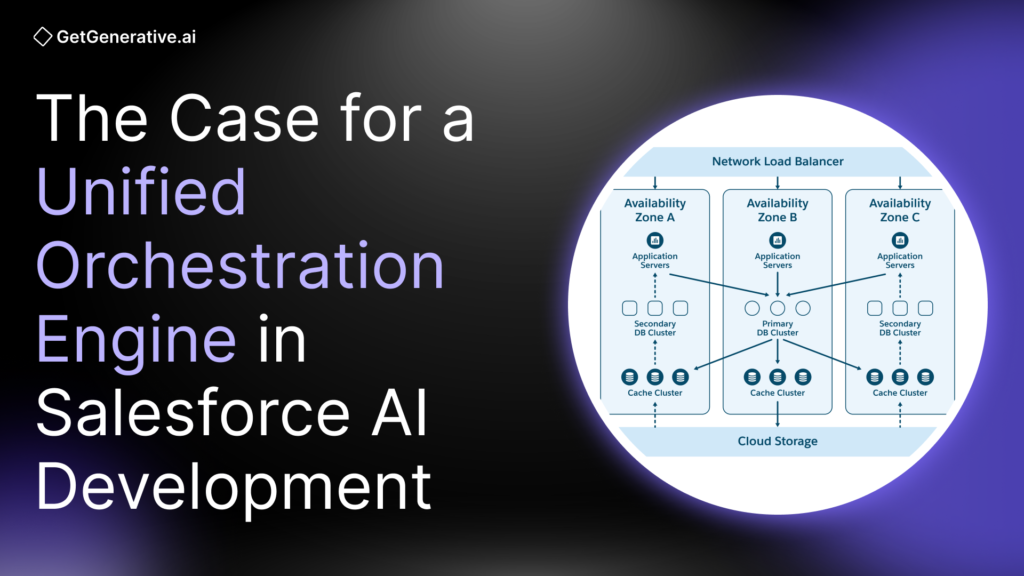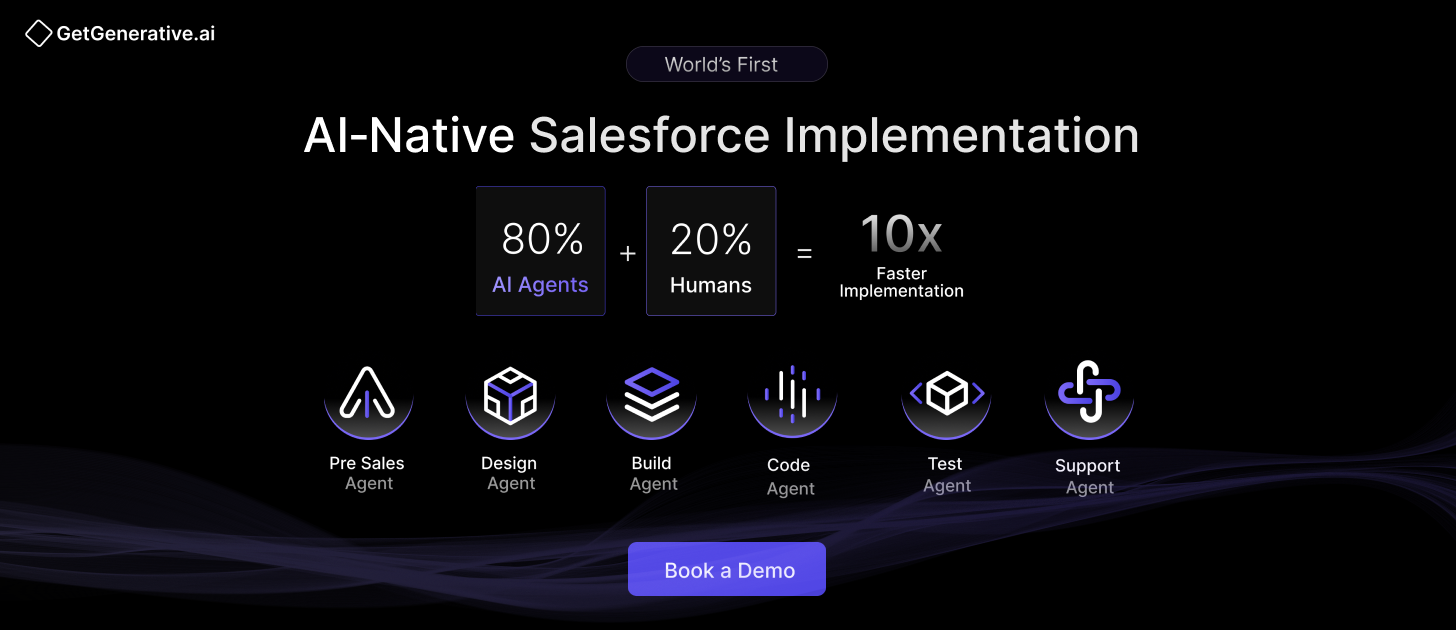The Case for a Unified Orchestration Engine in Salesforce AI Development
As conversational and agentic AI gain ground, experts are sounding the alarm.
Gartner notes that interest will “grow in a streamlined and unified orchestration engine that coordinates across AI models, systems of record, channels, and services.”
Salesforce has begun moving in this direction with Agentforce (including the Atlas Reasoning Engine), Flow Orchestration, MuleSoft protocols like MCP and A2A, and unified data layers via Data Cloud. But enterprises need more than scattered tools—they need a unified AI command center.
This blog makes the case for that missing link: a unified orchestration engine for Salesforce AI development. We’ll examine the core challenges, define what orchestration really means, explore how Salesforce is enabling this future, and provide strategic guidance for building such an engine. Let’s get started!
Challenges in Salesforce AI Development
1. Siloed Data and Systems
Modern Salesforce orgs are deeply interconnected, spanning CRM, ERP, marketing platforms, IoT data, and more. While Data Cloud aims to unify this information, in reality, data often remains fragmented across markets, teams, or clouds.
- Problem: AI models trained on Sales Cloud may be blind to service data or external context.
- Impact: Disjointed decisions, inaccurate predictions, and redundant efforts.
- Example: In one global enterprise, marketing and service teams worked on different customer profiles due to inconsistent orchestration, resulting in fragmented experiences.
2. AI Tool Sprawl and Duplication
Admins, architects, and developers can now access Einstein Discovery, Vision, GPT copilots, and external AI APIs. However, these are rarely coordinated.
- Salesforce reports that “thousands of models” are often deployed across orgs—yet few share workflows or learning.
- Result: Duplicated modeling efforts, uncoordinated outputs, and lost institutional knowledge.
As one Salesforce whitepaper notes, eliminating lifecycle inefficiencies is now a top priority for enterprise AI.
3. Integration and Governance Gaps
Integration remains the top technical barrier to AI adoption, with 95% of IT leaders identifying it as a significant obstacle. In AI-driven workflows, each new use case can result in bespoke integrations, unclear approval processes, and increased risk.
- Governance Blind Spots: 73% of Salesforce workers worry GenAI introduces new security risks.
- Data Strategy Gap: 59% of IT leaders lack a unified data foundation for their AI stack.
- Audit & Compliance Risk: Without orchestration, enterprises struggle to enforce consistent policies across AI agents, models, and output.
The bottom line: complexity is the enemy of scale. Without orchestration, Salesforce AI remains a set of isolated experiments—costly and hard to govern.
What Is a Unified Orchestration Engine?
A unified orchestration engine is more than a scheduler or process builder. It’s an intelligent, enterprise-grade framework that plans, executes, monitors and governs entire AI workflows—end-to-end. In the Salesforce ecosystem, this engine would connect AI agents, data services, cloud actions, and human approvals into coherent, scalable flows.
Core Capabilities of an Orchestration Engine
Capability | Description |
AI Agent Coordination | Directs which AI agents to invoke, in what order, and with what inputs (e.g., prediction → outreach → task assignment) |
Data Integration | Pulls and preprocesses data from Salesforce CRM, Data Cloud, external APIs, and unstructured sources |
Flexible Workflows | Supports conditional logic, human-in-the-loop steps, retry patterns, and parallel execution |
Embedded Governance | Enforces access controls, logs every action, and applies business guardrails automatically |
Scalable Execution | Manages concurrency, queues tasks, and provisions compute to meet performance SLAs |
This framework becomes the “central nervous system” of enterprise AI, much like Flow is for business automation.
Also Read – Why AI Struggles with Legacy Salesforce Orgs (And What You Can Do About It)
Foundations for Orchestration
Salesforce is not starting from scratch. Several key components already point toward a unified orchestration future:
Agentforce & Atlas Reasoning Engine
Agentforce is Salesforce’s agentic AI platform. At its heart lies the Atlas Reasoning Engine, which serves as an AI-native orchestrator. It breaks goals into steps, coordinates across specialized agents (e.g., service, billing, inventory), and ensures a cohesive outcome.
- Use Case: A logistics request could trigger inventory checks, service scheduling, billing calculation, and customer comms—all coordinated by Atlas.
- Benefit: AI agents act as a team, not as siloed bots.
MuleSoft MCP & A2A Protocols
MuleSoft is enabling agents and AI systems to communicate via:
- MCP (Model Context Protocol): Wraps APIs so they become callable by AI agents.
- A2A (Agent-to-Agent): Allows secure inter-agent communication across systems.
Together, these create a universal adapter for Salesforce, partner APIs, and even legacy systems—laying a foundation for orchestrated AI.
Flow and Flow Orchestration
Flow is evolving into the default orchestration layer across Salesforce.
- New Use Cases: Flow will soon replace Journey Builder and be central to Marketing Cloud Next.
- Cross-Cloud Power: Admins can now create multi-step workflows (e.g., case triage → approvals → resolution) across clouds and AI agents.
If AI actions are wrapped as Flow steps, then Flow becomes the orchestration user experience, allowing administrators and non-technical users to build AI-powered journeys.
Data Cloud & Trust Layer
Every orchestration engine depends on high-quality data. Salesforce’s Data Cloud ensures all AI models can access unified, governed customer profiles in real-time.
Paired with the Einstein Trust Layer, this enables:
- Data Grounding: Ensuring generative AI uses up-to-date records.
- Security Controls: Trimming sensitive fields, enforcing user permissions, and ensuring compliance.
- Auditability: Logging every inference, decision, and action tied to customer records.
With these pieces—Agentforce, Flow, MuleSoft, and Data Cloud—Salesforce is quietly assembling the building blocks of an orchestration layer. What remains is for enterprises to connect the dots.
Also Read – How Small Teams Can Deliver Enterprise-Level Salesforce Projects with AI
Benefits of a Unified Orchestration Engine
1. Faster Time-to-Value
AI workflows can be reused, extended, and scaled without rebuilding integrations. Once the orchestration engine is in place:
- Developers configure, not code.
- AI services become plug-and-play.
- PwC reports its Agent OS delivers new agents 10× faster than traditional methods.
This reduces the time from ideation to live deployment, directly accelerating innovation cycles.
2. Operational Efficiency at Scale
Salesforce’s internal orchestration engine for model training demonstrated 10,000 workflows per minute with sub-second latency. Extrapolated to AI applications:
- AI models can scale without latency degradation.
- Workloads are auto-distributed and optimized.
- Infrastructure is shared across flows, reducing resource overhead.
3. Unified Compliance and Governance
A centralized engine standardizes policies across AI outputs, data access, and audit requirements.
- Example: An AI-generated email must pass human review? The engine routes it through Flow approval.
- Benefit: Governance is embedded by design, not enforced post-deployment.
4. Lower Total Cost of Ownership (TCO)
Instead of managing disparate tools—each with its own orchestration logic—you maintain a single, unified orchestration layer. Cost savings include:
- Reduced dev effort on integration and monitoring
- Less duplication of infrastructure (connectors, job schedulers)
- Optimized compute usage across agents
5. Enhanced Agility and Iteration
Unified orchestration empowers business teams to experiment safely.
- Marketing teams can build and test “agentic journeys” directly in Flow.
- Service teams can adjust AI case workflows without IT rework.
6. Vendor-Agnostic Future-Proofing
The orchestration engine becomes the integration buffer between your AI stack and external services:
- Want to switch from OpenAI to Claude? Change the integration once in the engine.
- Need to add a compliance model from AWS? Plug it into the orchestration pipeline.
Also Read – Top AI Tools Every Salesforce Developer Should Know in 2025
Building a Unified Orchestration Engine in Salesforce
Now that we’ve established the “why,” let’s focus on the “how.” Here’s a phased roadmap for building your orchestration engine on Salesforce:
Step 1: Define AI Use Cases and Workflow Objectives
Identify high-impact flows:
- Sales: Lead scoring, follow-up automation
- Service: Ticket triage → knowledge bot → case closure
- Marketing: Segmentation → personalization → engagement
Document each flow’s data sources, model inputs/outputs, and business rules.
Step 2: Unify and Govern Your Data with Data Cloud
- Consolidate profiles, activity logs, and external sources
- Use Data Cloud as the real-time backbone for all AI decisions
- Ensure data governance policies are enforced before feeding into AI pipelines
As Salesforce emphasizes, Agentforce performance depends on clean, unified data.
Step 3: Standardize Workflow UX with Salesforce Flow
- Use Flow and Flow Orchestration for designing AI-enhanced journeys
- Incorporate external actions, Apex calls, and human approval points
- Provide training so admins and architects can build AI processes declaratively
Salesforce’s roadmap positions Flow as the default orchestration canvas—start building with that future in mind.
Step 4: Embrace MuleSoft MCP and A2A for Communication
- Wrap APIs using Model Context Protocol (MCP) to enable AI agent invocation
- Use Agent2Agent (A2A) to allow AI systems to collaborate securely
Standardizing on these protocols ensures your AI agents are modular, interoperable, and future-ready.
Step 5: Use MuleSoft to Orchestrate External Integrations
- Build API connectors for third-party services (ERP, logistics, marketing tools)
- Convert them into agent-ready interfaces via MuleSoft Flex Gateway
- Enable AI-to-system workflows (e.g., an agent checks delivery status via MuleSoft)
This makes every integration a reusable building block in orchestration.
Step 6: Deploy or Extend an Orchestration Framework
Depending on your enterprise maturity:
- Use Salesforce Flow + Apex for lightweight orchestration
- Deploy a third-party agent framework (e.g., PwC Agent OS)
- Extend Salesforce’s orchestration engine if available
At minimum, include:
- A workflow engine (Flow or external)
- State management (Salesforce objects or external DB)
- Logging and monitoring (Shield, SIEM, Flow logs)
- Execution runtimes (Heroku, AWS Lambda, or AI services)
Step 7: Bake Governance and Audit Into the Design
- Define AI guardrails: what actions require approval?
- Use Shield or event monitoring for full traceability
- Enforce role-based access, data masking, and compliance triggers
Design for responsible AI from the start.
Step 8: Pilot with a Focused Use Case
Start small. Prove ROI. Measure outcomes.
- Time saved
- Accuracy of predictions
- Compliance pass rates
- Business KPIs (e.g., conversion, CSAT)
Then scale to additional flows using the same engine.
Step 9: Upskill Teams and Drive Adoption
Invest in training across roles:
- Admins: Flow + governance
- Devs: APIs, Apex, orchestration tools
- Architects: Data strategy, integration patterns
- Business: Interpreting AI flows and outputs
Communicate the why behind orchestration. Internal trust is as critical as model accuracy.
Conclusion
As AI expands across Salesforce orgs, fragmentation becomes the bottleneck. Without orchestration, enterprises face slower delivery, higher risk, and inconsistent governance.
The solution? A unified orchestration engine that coordinates every AI component—from data to agents to outputs. It aligns with Salesforce’s direction: Agentforce for agent coordination, Flow for orchestration UX, MuleSoft for connectivity, and Data Cloud for real-time data.
At GetGenerative.ai, we’ve reimagined Salesforce implementation—built from the ground up with AI at the core. This isn’t legacy delivery with AI added on. It’s a faster, smarter, AI-native approach powered by our proprietary platform.
👉 Explore our Salesforce AI consulting services




